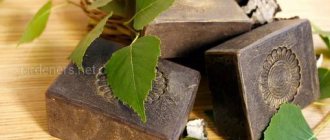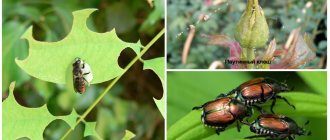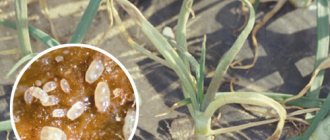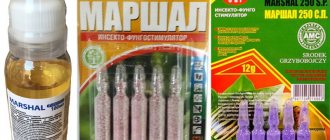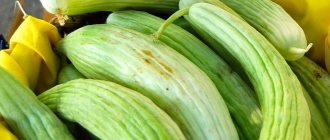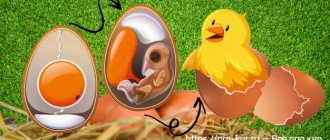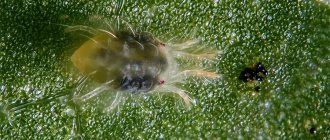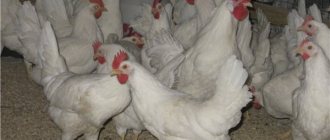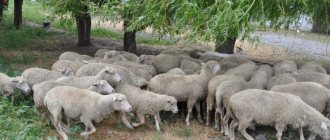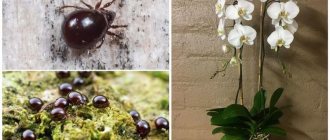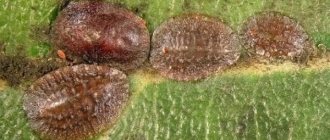Everyone knows that viburnum berries are healthy, because they contain a lot of vitamin C and other nutrients necessary for human life.
A decoction of berries helps against sore throat, bronchitis, even pneumonia.
The bark has no less useful properties, because it helps stop bleeding in case of a wound or cut, and can serve as a rinse in the treatment of periodontal disease.
Knowing which insects can cause harm to this medicinal shrub, you can take preventive measures.
About
Top most common viburnum pests
Insects can cause harm.
However, not everyone knows how to deal with them. Let's look at the types of parasites, as well as methods of pest control.
Black aphid
These small pests are tiny in size and dark (black or dark brown) in color. These insects usually intend to lay their eggs on the stem.
After hatching, their larvae drink the juices of the bush, it dries out and changes its appearance.
Aphid larvae are resistant to chemicals and severe frosts.
Control measures
It is necessary to spray the bush three times a year, since the insect can attack more than three times a year, and hatched insects can fly to any other plant.
Green lobed moth
This is a caterpillar that eats flowers. It has a bright green color, with a red stripe along the entire body.
Green moth
It can also cause harm to lilac and buckthorn. It has an active period from late spring to mid-summer.
It is also found on decorative varieties of viburnum. We also advise you to read about one of them: Kalina Gordovina.
Control measures
If not destroyed in time, many larvae can be deposited, which can lead to the death of plants in the future. A solution of Karbofos is used as a chemical effect on it.
Viburnum leaf beetle
Viburnum leaf beetles are dark brown in color and usually lay eggs in viburnum shoots. The larvae look like worms, have a grayish body and a dark head.
Viburnum leaf beetle
After hatching in late spring, they eat the leaves of the plant. Sometimes you can even notice when, in just a couple of days, instead of a leaf, only its skeleton remains. The parasites are usually attached to the bottom of the leaf and are difficult to get rid of.
This pest loves dampness, you need to beware of rainy weather and fight insects prematurely. A damaged plant may not survive frost and die.
Control measures
- To get rid of harmful insects, you need to tear off dried and insect-infested leaves in advance.
- It is worth processing either in spring or late summer. Intavir will cope with this task; you need to treat the plant twice with an interval of a week.
- As we found out earlier, to improve the effect, it is also possible to spray viburnum with tinctures of red capsicum, a decoction of chamomile and onions.
- Visual control of plant growth: you can cut off those parts of the plant that already have a clutch of eggs, and then burn them.
Viburnum leaf roller
These insects are active in the spring. Their larvae are grayish in color with yellow areas on the sides.
Viburnum leaf roller
The entire surface of the body is covered with small light hairs.
Their harm lies in the fact that they can eat all the buds of the viburnum in a short time, and their web injures the young leaves of the plant.
Control measures
These pests also need to be destroyed.
Methods to combat them include burning all their clutches and nests, spraying plants with Nitrophen paste.
Raspberry gall midge
These pests only damage viburnum inflorescences. They lay their eggs inside the bud, which changes its appearance and color. The bud does not open, becomes swollen, large and red.
Raspberry gall midge
Prevention measures
In March and November, weed all the soil; eggs of future parasites mature there. Spray viburnum with Karbofos solution.
Chekhlik moth
The adult moth looks like a small butterfly, with gray and shiny wings. It becomes active in the spring and uses viburnum leaves as food.
Moth larvae are light brown in color and very small in size. Butterflies appear in July and almost immediately damage the plant.
Control measures
Fufanon, Iskra and Intavir are suitable for you to help fight these insects. But the best time to treat viburnum for pests is in the spring, when the buds open.
Other insect pests
Spider mites, sawflies and moths can cause just as much damage to a vulnerable plant.
Control measures
Karbofos will help fight them. It should be used in late spring.
Spider mite
Moth
Viburnum leaf roller Description
The larvae of the viburnum leaf roller are caterpillars of a grayish or greenish-olive color, which, immediately after emerging in the spring, begin to actively eat the buds and young leaves of the viburnum.
At the same time, they entangle the leaves with cobwebs, knocking them into a ball. In mid-summer, the caterpillars pupate.
If conditions are favorable, they are able to gnaw out large areas of foliage in a short time, which has a very negative impact on crop yields.
How to deal with viburnum leaf roller
- Mechanical collection of nests along with pests and their subsequent burning will help get rid of caterpillars.
- It is also recommended to treat the viburnum bush with nitrafen paste before the buds open, and with karbofos after they open.
- During the period of mass appearance of insects, it is necessary to apply 0.05% Inta-Vir or Decis (dissolve 1 tablet in 10 liters of water). After two weeks, the procedure is repeated.
How to treat viburnum for pests
How to spray viburnum against pests, if we talk about chemicals, then the following are suitable:
- Arrivo;
- Fufanon;
- Syngenta "Aktara";
- Commander;
- Corado.
How to protect viburnum from pests without chemicals
Biological preparations include planting plants around viburnum that can repel insects.
- Chamomile
- Garlic
- Onion
After all, insects navigate in space by smell. Certain plants emit aromatic substances that repel pests.
For your information. Finding food for pests becomes much more difficult if there are too many other plants around, distracting them from their original goal.
Mechanical methods include spraying the plant with strong pressure of water from under a hose.
It is better to do all this before the buds open, as this will help reduce the number of larvae that have survived severe frosts.
You can use decoctions of potatoes, capsicum or celandine.
For your information. A ladybug or hoverfly will cope with the destruction of pests. They will only feed on insects, but they will not be able to harm the viburnum.
Ladybug
Choosing a landing site
Buldenezh loves moist soils, so it grows better near bodies of water and in low-lying areas where moisture is better retained. If you do not have such an area on your site, you will have to artificially keep the soil moist. Perhaps this is the most important condition for choosing a landing site. Otherwise, the plant is unpretentious to the soil and finds everything it needs for its growth in any of them. The shrub tolerates heat well provided it is irrigated. It is not afraid of winds, but must be tied up, as it has fragile wood and the wind can easily break it.
Buldenezh is planted as a single bush or a group of plants. It creates a wonderful shade, so it is good to locate it near a garden bench or gazebo. When the planting site has been determined, you need to carefully prepare a hole for seedlings, since a good supply of fertilizers will be the key to healthy and rapid growth of the plant.
Folk methods of struggle
Some gardeners adhere to natural methods of pest control.
One of the simplest and most accessible methods is a soap solution of laundry soap. Please note that soap shavings are easier to dissolve.
This method cannot harm humans. If you want to enhance the effect, you can add soda, ash, tobacco, or tomato tops.
Soap solution with soda
The method of preparing it is quite simple: in a bucket of water you need to mix half a bar of laundry soap and 10 tablespoons of soda.
The effect after spraying can be seen in the evening.
Soap solution with ash
It is a known fact that ash can cause severe harm to the skin of insects. Therefore, it is also a fairly popular folk method in the fight against parasites.
Advice. After spraying the plants with an ash solution, you can fix the effect with a soap solution. In this case, you will see the results of use very soon.
Tobacco leaf solution
Method of preparation: add a couple of red pepper pods to 200-300 grams of dry tobacco leaves and add water. Leave to infuse for a day.
To enhance the effect, you can add a little soap shavings and a couple of tablespoons of ash. Such a solution is capable of killing all treated insects in the shortest possible time.
Tops solution
This solution may include both potato and tomato tops. Chopped greens are poured into a bucket of water. Insists.
After this, you should boil it a little over the fire, cool, and add soap shavings.
Near the viburnum, you can also plant plants that will unnecessarily attract attention to themselves, diverting it from the viburnum bushes.
These include:
- Begonia;
- Nastrium;
- Mallow;
- Linden.
Mallow
These plants are a real paradise for parasites. Keep this in mind when planning your garden plot.
Sparrows, tits and warblers can also become your helpers in the fight against unwanted insects. You can attract them with the help of drinkers and feeders on your territory.
These birds will be happy to clear the land of unwanted guests.
Unfortunately, not all folk remedies are capable of removing pests 100%, but, as practice has shown, not even all chemicals cope with this.
Therefore, if you want to reliably achieve results in the shortest possible time, you should combine all the methods available to you.
Chemicals
Options for chemical treatment of viburnum leaves are as follows:
Before the bush begins to flower, the leaves are sprayed with a 60% solution of nitrafen in a ratio of 200 grams of liquid per 10 liters of water.
From the beginning of the spring period and a month before harvesting the fruits, a solution of karbofos or funanone is used. Be sure to use personal protective equipment.
Pest Prevention
The most reliable way to prevent viburnum from diseases and pests is to regularly inspect it.
- Carefully inspect each leaf, inflorescence, and stem itself. If you see that the plant has begun to change shape, color, rot or dry out, you must immediately look for the problem and take measures to eliminate it.
- As a preventative measure, you can safely use the above-described decoctions and self-prepared soap solutions.
In this article, we examined in detail all the insects that can harm viburnum, the types of control against them, as well as ways to prevent diseases of the plant itself.
Follow these effective tips, and then your viburnum will never get sick.
Soil preparation
For a single bush, a hole measuring approximately 60 × 60 × 80 cm is prepared. Then the hole must be spilled with a large amount of water, especially if the planting site is chosen on a flat or elevated area. Next, you need to lay drainage at the bottom of the hole, which will allow water not to stagnate near the roots. It may consist of tree bark, stones and other materials. Almost the entire space of the pit must be filled with a nutrient mixture of potassium-phosphorus fertilizers, peat, humus, old leaves, ash and garden soil, and the pit must be flooded with water again.
Botanical characteristics
When thinking about purchasing a seedling of this beautifully flowering shrub, you should remember that you need quite a lot of space so that planting and care can be carried out without problems. Viburnum buldenezh characteristics are as follows: this plant of the Adoxaceae family is quite large, and with good care, ten years after planting, it can grow up to 3 meters in height. Its crown is large, spreading, and in adulthood its width reaches 4 meters. This shrub has light green large leaves 10-12 cm long. The most important decoration of decorative viburnum is its snow-white flowers, collected in huge inflorescences, the diameter of which can be more than 20 cm. The variety is sterile, that is, it practically does not form seeds, which determines its characteristics its reproduction. This plant is quite frost-resistant and has taken root well throughout the European territory of Russia, with the exception of the Far North and southeastern regions.
An ornamental plant such as viburnum buldenezh (planting and care must be carried out taking into account all the characteristics of the bush) can delight with its flowering for 50-60 years.
Trimming
Viburnum pruning is carried out for the purpose of sanitary cleaning, rejuvenation and crown formation. When sanitary pruning of shrubs, dry, broken and diseased shoots are systematically removed. All viburnums have a long period of shoot growth, the durability of its trunks is more than 30 years. Therefore, anti-aging pruning on viburnum is carried out no more often than after 5-7 years. Old branches are cut down to the point where stem shoots appear, leaving about 20-25 strong and large shoots. This thinning of the viburnum crown can be done in winter or early spring, in early April. It is recommended to cut bushes with weakened flowering “to the stump” at a height of 15-30 cm from the root collar. After pruning, strong young shoots develop from dormant buds, and the bush is completely restored. For abundant flowering of viburnum, it is recommended to pinch out strongly growing young shoots.
How to propagate?
Above we have already talked about how to propagate viburnum buldenezh by layering, but there are other ways: by dividing the root or cuttings.
The easiest way is to divide the root. If there is already a well-established and actively growing viburnum of the Buldenezh variety on the site, you need to carefully examine the plant and find a young lateral shoot. It should be carefully separated from the main bush and planted in the chosen location.
Propagation by cuttings is somewhat more difficult, since it takes quite a long time for them to take root. If this method is more convenient for you, then in July you need to cut off last year’s healthy shoot about 8 cm long with 6-8 buds. Then the cuttings are planted to a depth of 3-4 cm in fertile and well-fertilized and moistened soil, and then covered with film or a cut plastic bottle. After the roots form, the young plant is transplanted into a pot and left warm until autumn. With the onset of cool weather and until May next year, the seedlings are kept in a cool room. After the soil has warmed up well, in late spring - early summer of next year, young plants are planted in a permanent place.
Care
Caring for this type of crop is not difficult. Traditional pruning of broken and frozen branches is carried out in early spring; in late autumn, gardeners remove all disease-affected shoots and those branches that are damaged.
On the eve of winter, you can carry out corrective pruning of shoots to maintain or improve the shape of the crown. It is during these days that the tree will painlessly survive the transformation into a bush: you just need to cut it down to the height required for the bush. In the spring, the remaining stump will produce abundant shoots.
By the way, shoots will also come from the root system.
If the gardener does not have the goal of growing a living green wall with balls of white inflorescences, such branches should be removed in the spring. We treat the cut area with copper sulfate and apply a layer of garden varnish. Important !
If the summer turns out to be dry, buldenezh requires constant additional moisture of the roots. In mid-autumn, buldenezh should be thoroughly watered. An abundant supply of water will give impetus to the growth of the root system. In addition, it will strengthen the tree itself and its roots, and it will be easier for the viburnum to survive winter frosts.
Fertilizer
Buldenezh, like other garden trees, needs to be fertilized. The flowering and fruiting of the crop directly depends on this. The nutrient mixture that the seedling received during planting gives it the strength to develop for the first couple of years.
Then comes the turn of nitrogen fertilizing, which is effective for spring fertilization of plants. Although at this time you can get by with compost. At the same time, in early spring, for more active flowering, we treat the branches with fertilizer containing boron. Autumn fertilizing is, first of all, fertilizers with a high content of phosphorus and potassium.
There are two acceptable methods for adding nutrients here. In the first case, we scatter the additive around the trunk, mix it with the soil with a rake and pour a couple of watering cans onto the roots. In the second, we make several holes on the ground near the trunk with a garden drill; going 25-30 centimeters deep is enough. Take the fertilizer and carefully read the instructions. Distribute the prescribed amount of powder between the holes, fill it in and water it generously.
To cut or not?
Many of those who have viburnum buldenezh growing on their property ask a similar question. Planting and care, shelter for the winter - all these are mandatory and understandable procedures, but few people know why pruning is needed. In fact, in order for this decorative viburnum to form a lush and beautifully shaped crown, it needs to be pruned annually, but just be sure to remember some of the plant’s features. Formative pruning can be carried out only after the plant has flowered, shortening the side shoots, cutting out dried branches and thinning the middle of the bush. At the very end of summer, you should not prune the plant, as at this time it is preparing for the onset of cold weather. To improve flowering, young branches of buldenezh are pinched at the end of July - beginning of August. It is important to remember that this variety of viburnum buds and blooms only on last year’s shoots, and that is why you should not touch them.
When did this variety appear?
The viburnum variety Buldenezh, in contrast to simple forms such as Canadian, serrated, black and others, is considered “aristocratic”. It was bred by the most famous breeder of his time, Victor Lemoine. Boule de Neige translated from French means “snowball”, “snow globe”, which corresponds to the impression of a flowering bush.
Widespread in European countries, only in the middle of the 18th century, thanks to the Russian Tsarina Catherine II, viburnum buldenezh came to Russia. Planting, care, and propagation of this plant in the royal greenhouses and parks were entrusted to specially invited foreign specialists. Quite quickly, the fashion for “snowball,” as this decorative variety began to be called, spread in high society, and some nobles created gardens entirely consisting of bushes of this variety of viburnum.
How to plant correctly?
If the planting hole has been properly prepared, then you need to plant the plant correctly. First of all, you should remove the seedling from the container and straighten the roots. You can sprinkle them with any root formation stimulator and place the plant in the prepared hole. It is important that the root collar is located several centimeters below the ground level. Then the remaining space in the hole is filled with garden soil, being sure to compact it strongly so that there are no air “pockets” left. The planted bush must be watered abundantly, and the hole must be mulched with humus, sawdust, crushed tree bark or peat chips, which will significantly reduce moisture evaporation.
Suitable site
Bearing in mind that this shrub grows quite quickly and is not very compact, you should choose a place where Viburnum buldenezh will settle for several decades. Planting and care (see photo of the plant below) are simple and accessible even to novice gardeners.
The optimal location for this beautifully flowering shrub would be a semi-shaded corner in the garden, illuminated by sunlight only part of the day. Like any other viburnum, the Buldenezh plant prefers moist soil, but if you plant it in dry soil and provide adequate watering, then every year it will delight you with its appearance and flowering.
Viburnum and honeysuckle gall midge
These viburnum pests attack plant flowers. The larvae of the viburnum gall midge are white, and the honeysuckle gall midge is red. They spend the winter in the upper soil layer, wrapped in spider cocoons. Adult gall midges reveal themselves when the buds are exposed. Female gall midges like to lay eggs inside the bud, and the larvae also develop here. Due to this, the buds become ugly, significantly increase in size, swell, turn red, the corolla thickens, and the pistil and stamens are greatly retarded in development, the flowers cannot open. Viburnum pests produce only one generation.
Control measures
To combat gall midges, it is necessary to loosen the soil in early spring and late autumn, and before and after flowering of the viburnum, it is necessary to spray with 10% karbofos at the rate of 100 g of the substance per bucket of water.
Honeysuckle spiny sawfly
The sawfly damages decorative and edible honeysuckle and viburnum. The pest larva has an olive-colored body and two transverse rows of white spines, with a dark red back or mesh pattern, light gray sides and a yellow head. The larvae overwinter in the top layer of soil. Pupation occurs in the spring. Adult pests appear when the leaves bloom, on which the females lay eggs. The hatched larvae eat the leaves. They can eat until they are completely naked.
Control measures
To combat the sawfly, autumn digging of the soil is effective. Then you need to spray the bushes before flowering and after it with 10% karbofos (100g per bucket of water), and also treat the plant with wormwood decoction (750g of dried grass per bucket of water) or garlic, tobacco, onions (200g tobacco waste or dust, 200g ground onions or garlic and 200g of onion peel per bucket of water).
We apply fertilizers
It is important that the hole is well prepared and “filled”, that planting and care are carried out correctly. Viburnum buldenezh's growth will be as follows: up to 30 cm per season. As a rule, they begin to apply fertilizers to this ornamental shrub in the second or third year after planting, since the nutrients stored in the planting hole have run out by this time. The first application of fertilizers, complex or nitrogen-containing, is best done in the spring, during the opening of the buds and the appearance of the first leaves.
The second time Boule de Neige is fed with special autumn or potassium-phosphorus compounds in the fall, before the bush sheds its leaves. You can fertilize this variety of viburnum only with organic fertilizers, such as rotted compost or humus, adding about 1-2 buckets under each bush in the spring and lightly digging up the top layer of soil.
When to plant?
Both in autumn and spring, you can plant a plant such as viburnum buldenezh in open ground. Planting and caring for a seedling transplanted in the spring is easier, and the shrub adapts better to new conditions on warm summer days.
Fall planting can be risky, especially in rainy and cold weather, as there is a high chance that the plant will not take root and survive. Experienced gardeners propagate the Boule de Neige viburnum by layering in the spring. To do this, annual branches are carefully tilted to the ground and pinned, after which they are covered with last year's compost or humus and watered well. After the cuttings have roots, the seedling is hilled up and provided with constant moisture.
Preventive actions
To prevent the appearance of aphids on viburnum, every spring you need to clean the bush of old peeling bark, under which there may be masonry, and whitewash the trunk with lime. You should also regularly cut out root shoots and tops.
How to fight moles in the garden using folk remedies?
If there are ants in the garden that contribute to the development of aphids, it is necessary to get rid of them by pouring boiling water over the areas where they accumulate. But some insects, such as ladybugs, should be attracted to the garden because they eat aphids.
